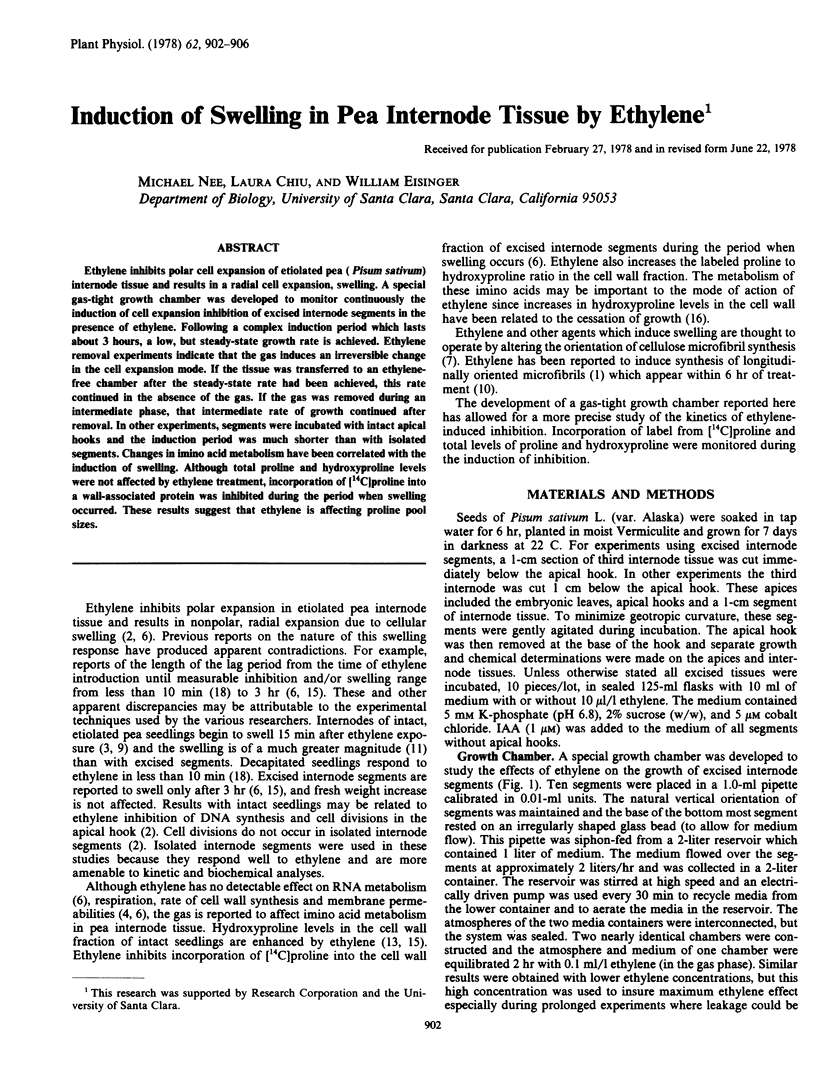Abstract
Ethylene inhibits polar cell expansion of etiolated pea (Pisum sativum) internode tissue and results in a radial cell expansion, swelling. A special gas-tight growth chamber was developed to monitor continuously the induction of cell expansion inhibition of excised internode segments in the presence of ethylene. Following a complex induction period which lasts about 3 hours, a low, but steady-state growth rate is achieved. Ethylene removal experiments indicate that the gas induces an irreversible change in the cell expansion mode. If the tissue was transferred to an ethylene-free chamber after the steady-state rate had been achieved, this rate continued in the absence of the gas. If the gas was removed during an intermediate phase, that intermediate rate of growth continued after removal. In other experiments, segments were incubated with intact apical hooks and the induction period was much shorter than with isolated segments. Changes in imino acid metabolism have been correlated with the induction of swelling. Although total proline and hydroxyproline levels were not affected by ethylene treatment, incorporation of [14C]proline into a wall-associated protein was inhibited during the period when swelling occurred. These results suggest that ethylene is affecting proline pool sizes.
Full text
PDF




Selected References
These references are in PubMed. This may not be the complete list of references from this article.
- Apelbaum A., Burg S. P. Altered Cell Microfibrillar Orientation in Ethylene-treated Pisum sativum Stems. Plant Physiol. 1971 Nov;48(5):648–652. doi: 10.1104/pp.48.5.648. [DOI] [PMC free article] [PubMed] [Google Scholar]
- Apelbaum A., Burg S. P. Effect of Ethylene on Cell Division and Deoxyribonucleic Acid Synthesis in Pisum sativum. Plant Physiol. 1972 Jul;50(1):117–124. doi: 10.1104/pp.50.1.117. [DOI] [PMC free article] [PubMed] [Google Scholar]
- Burg S. P., Burg E. A. Ethylene formation in pea seedlings; its relation to the inhibition of bud growth caused by indole-3-acetic Acid. Plant Physiol. 1968 Jul;43(7):1069–1074. doi: 10.1104/pp.43.7.1069. [DOI] [PMC free article] [PubMed] [Google Scholar]
- Burg S. P., Burg E. A. The interaction between auxin and ethylene and its role in plant growth. Proc Natl Acad Sci U S A. 1966 Feb;55(2):262–269. doi: 10.1073/pnas.55.2.262. [DOI] [PMC free article] [PubMed] [Google Scholar]
- Burg S. P. Ethylene in plant growth. Proc Natl Acad Sci U S A. 1973 Feb;70(2):591–597. doi: 10.1073/pnas.70.2.591. [DOI] [PMC free article] [PubMed] [Google Scholar]
- Eisinger W. R., Burg S. P. Ethylene-induced Pea Internode Swelling: Its Relation to Ribonucleic Acid Metabolism, Wall Protein Synthesis, and Cell Wall Structure. Plant Physiol. 1972 Oct;50(4):510–517. doi: 10.1104/pp.50.4.510. [DOI] [PMC free article] [PubMed] [Google Scholar]
- Irvine R. F., Osborne D. J. The effect of ethylene on (1-14C)glycerol incorporation into phospholipids of etiolated pea stems. Biochem J. 1973 Dec;136(4):1133–1135. doi: 10.1042/bj1361133. [DOI] [PMC free article] [PubMed] [Google Scholar]
- Ridge I., Osborne D. J. Role of peroxidase when hydroxyproline-rich protein in plant cell walls is increased by ethylene. Nat New Biol. 1971 Feb 17;229(7):205–208. doi: 10.1038/newbio229205a0. [DOI] [PubMed] [Google Scholar]
- Rojkind M., González E. An improved method for determining specific radioactivities of proline-14C and hydroxyproline-14C in collagen and in noncollagenous proteins. Anal Biochem. 1974 Jan;57(1):1–7. doi: 10.1016/0003-2697(74)90043-8. [DOI] [PubMed] [Google Scholar]
- Sadava D., Chrispeels M. J. Hydroxyproline-rich cell wall protein (extensin): role in the cessation of elongation in excised pea epicotyls. Dev Biol. 1973 Jan;30(1):49–55. doi: 10.1016/0012-1606(73)90047-x. [DOI] [PubMed] [Google Scholar]
- Sadava D., Walker F., Chrispeels M. J. Hydroxyproline-rich wall protein (extensin): biosynthesis and accumulation in growing pea epicotyls. Dev Biol. 1973 Jan;30(1):41–48. [PubMed] [Google Scholar]
- Warner H. L., Leopold A. C. Timing of growth regulator responses in peas. Biochem Biophys Res Commun. 1971 Aug 20;44(4):989–994. doi: 10.1016/0006-291x(71)90809-6. [DOI] [PubMed] [Google Scholar]


